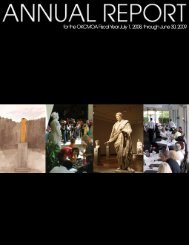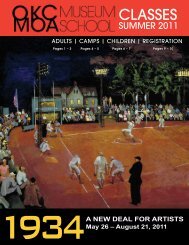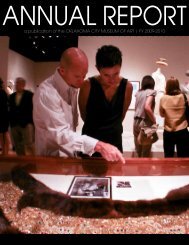Roman Art from the Louvre Educators' Resource Guide
Roman Art from the Louvre Educators' Resource Guide
Roman Art from the Louvre Educators' Resource Guide
Create successful ePaper yourself
Turn your PDF publications into a flip-book with our unique Google optimized e-Paper software.
12<br />
Each god, goddess, and spirit was related to a specific action or purpose.<br />
For example, Minerva was <strong>the</strong> goddess of wisdom, crafts, and industry; and<br />
Mercury was <strong>the</strong> messenger of <strong>the</strong> gods and <strong>the</strong> protector of travelers, merchants,<br />
and thieves. Religion was a public and communal act. Religious<br />
festivals and ceremonies were held in public spaces in order to accommodate<br />
<strong>the</strong> faithful. Smaller scale cult worship and private, household worship<br />
were dedicated to minor deities that were deemed personally auspicious.<br />
<strong>Roman</strong> religion was also considered poly<strong>the</strong>istic because <strong>the</strong> gods were<br />
omnipresent, presiding over all areas of activity.<br />
The temple was considered <strong>the</strong> deity’s dwelling place and was <strong>the</strong> setting<br />
for its cult statue. The most important element in a place of worship was <strong>the</strong><br />
altar, which was used for sacrifices. In urban planning, <strong>the</strong> temple, which<br />
was often located amid o<strong>the</strong>r public buildings, was closely associated with<br />
all types of daily activities. Gods and men are said to have inhabited <strong>the</strong><br />
same time and space in ancient Rome. The calendar listed <strong>the</strong> various civic<br />
activities—military and political activities as well as planting and harvesting<br />
schedules—and it was divided between dies fasti (days of <strong>the</strong> gods)<br />
and dies nefasti (days of <strong>the</strong> earthly realities). The year was highlighted<br />
by numerous festivals featuring sacrifices. These frequently culminated in<br />
<strong>the</strong>ater or circus games that took place before <strong>the</strong> eyes of <strong>the</strong> deity, as represented<br />
by a statue brought in by procession.<br />
<strong>Roman</strong>s believed that <strong>the</strong>y maintained <strong>the</strong> world’s equilibrium through<br />
<strong>the</strong>ir devoutness, which was expressed primarily in <strong>the</strong>ir meticulous execution<br />
of prescribed rituals. During <strong>the</strong>se rites, each citizen created special<br />
ties with <strong>the</strong> gods; <strong>the</strong> gods in turn took part in all civic activities. During<br />
divination rites, <strong>Roman</strong>s sought to obtain assistance <strong>from</strong> <strong>the</strong> gods in making<br />
important decisions. When an animal was sacrificed, <strong>the</strong> portion that<br />
was burned on <strong>the</strong> altar was reserved for <strong>the</strong> deity, with mortals consuming<br />
<strong>the</strong> rest during a banquet. The faithful could also communicate with<br />
gods through offerings of food, wine, flowers, personal objects, and even<br />
portrait figurines. Such offerings were bestowed as gestures of reconciliation,<br />
as a sign of thanks, or in fulfillment of a vow.
















